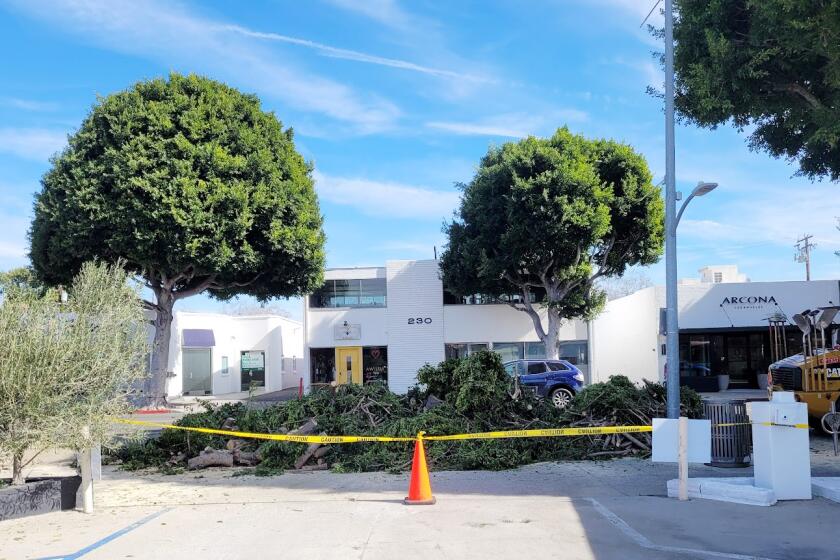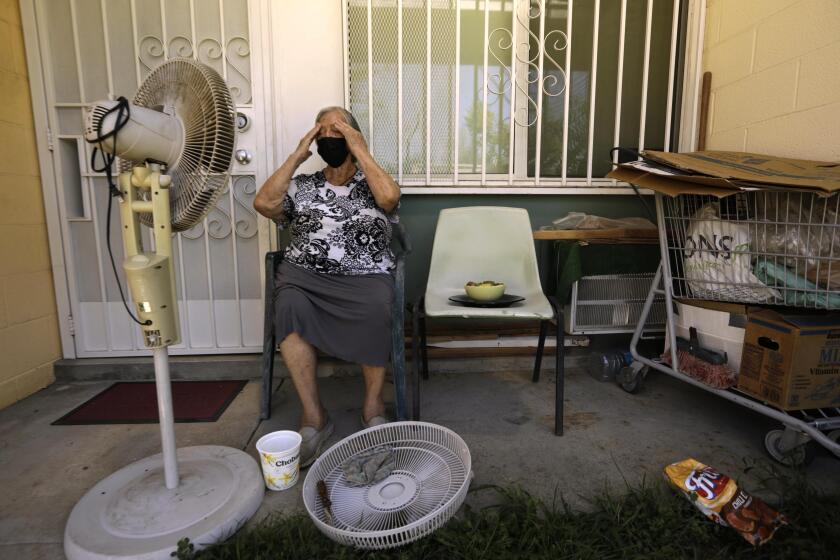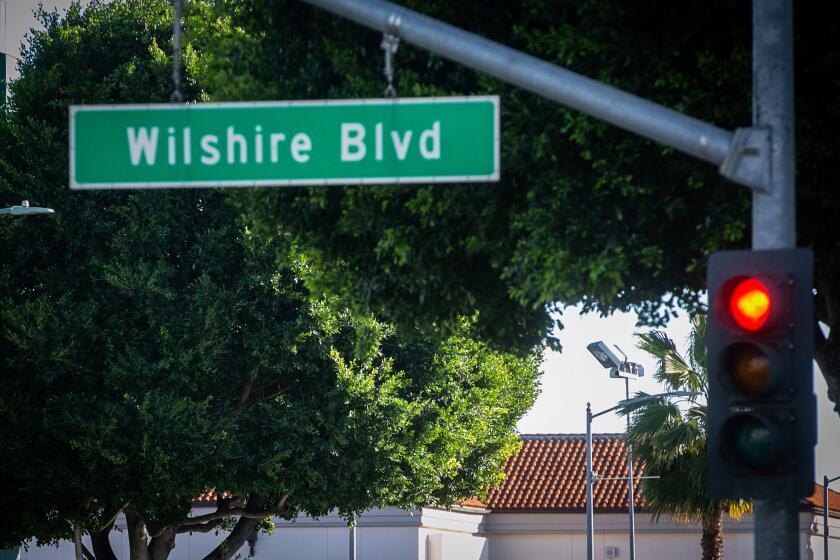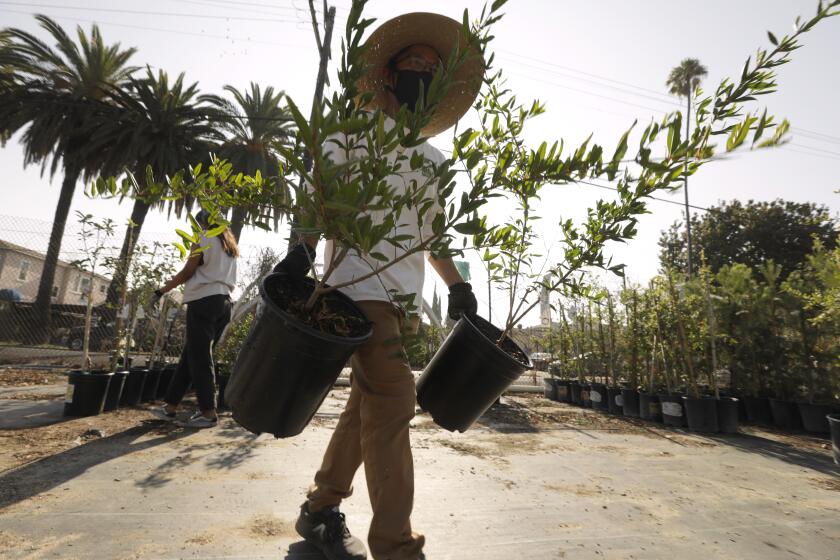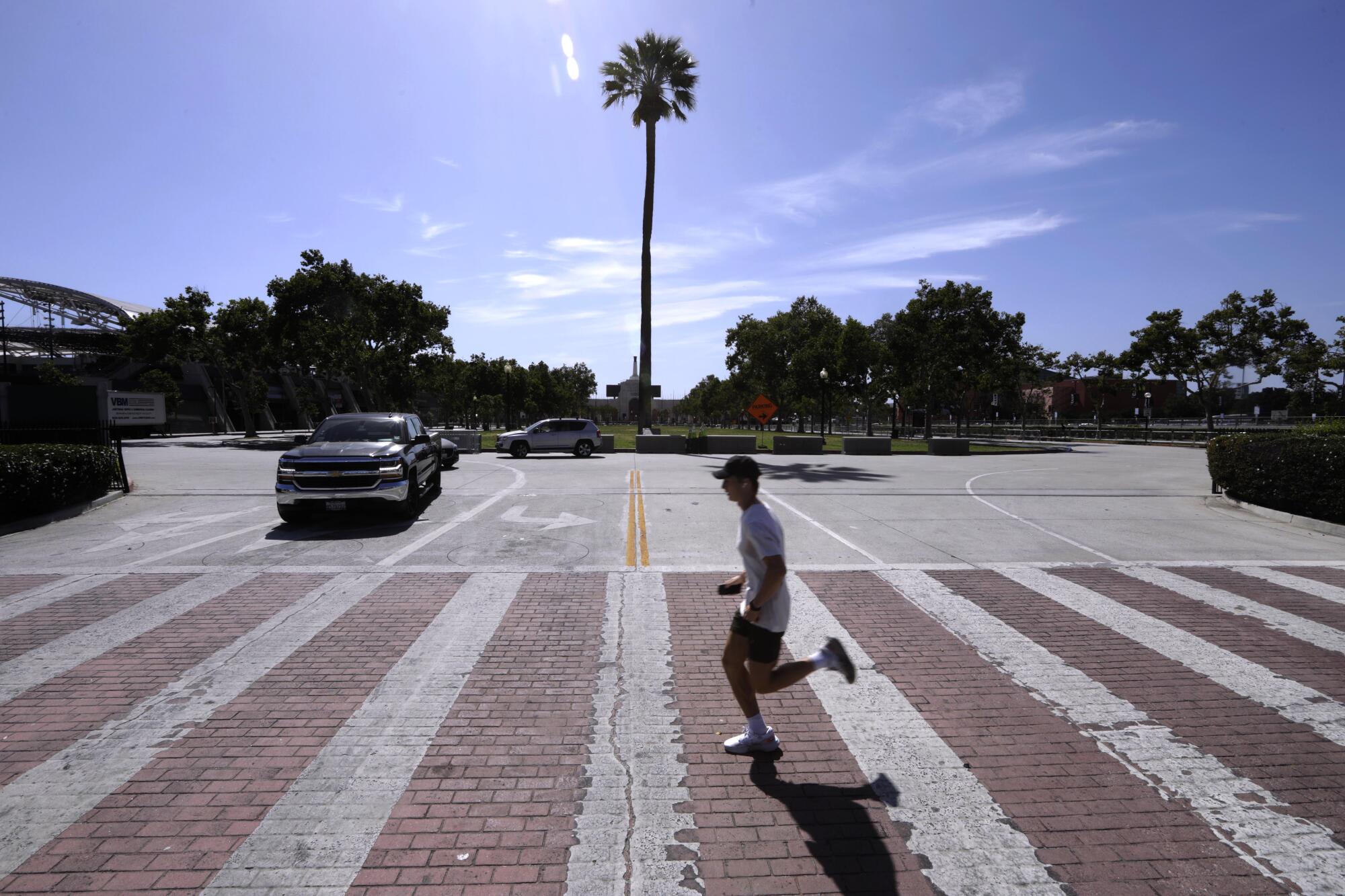
- Share via
As an urban runner, V. Kelly Turner is always looking for some shade. She doesn’t want to overheat.
Most weekday mornings, her usual route takes her down the shadiest stretch of Los Feliz Boulevard, where lush deodar cedars flank the sidewalks. One of her longer routes takes her through Hollywood on her way to Sunset Boulevard.
“That stretch is hard,” said the associate professor of urban planning and geography at UCLA. “There’s not a lot of shade. Just palms. I’ve actually changed my route to avoid it.”
Like Turner, cities across California are struggling to navigate a warming world, as well as mitigate the effects of urban heat islands. Many have developed climate action and resiliency plans that use trees as a primary defense against sizzling asphalt and stone.
Yet as officials seek to greatly expand the urban tree canopy — with House Republicans often suggesting planting a trillion trees to fight climate change — many cities are razing their shadiest and most mature trees. In some cases, they are replacing them with palms.
Aggressive and impactful reporting on climate change, the environment, health and science.
In Beverly Hills, crews felled more than 50 ficus trees, ranging from 60 to 100 years old, along Robertson Boulevard for a sidewalk restoration project. The city plans to replace them with alternating crape myrtles and Mexican fan palms. Similarly, a pavement restoration plan underway in Long Beach has involved chopping down about 150 lemon-scented gums, a type of eucalyptus, some 90 feet high. The city said it anticipates planting more than 5,000 plants along the corridor, and approximately 260 myrtles and 130 palms.
“As a heat scholar, I look at palm trees and I think that they don’t really do much in terms of heat mitigation,” said Turner, whose work focuses on cities adapting to hotter conditions. “A pole on the side of the street isn’t providing much shade. And a palm tree is kind of similar.”
With their towering trunks and thick fronds, palms have long dominated the skyline of the Los Angeles Basin, symbolizing for many the region’s sunny promise of prosperity. As such, they are important to local economies and embedded in the region’s cultural identity. None are native to the area, however.
In the 1800s and 1900s, new Angelenos imported palms from elsewhere in the world. In the 1930s, the city underwent its biggest palm planting boom, with more than 25,000 palms planted in 1931 alone.
“They conjure up images of far off, exotic, tropical rainforests, which is a far cry from what I grew up in here in California,” said Donald R. Hodel, emeritus horticulture adviser for the UC Cooperative Extension in L.A. County and a lifelong palm researcher.
But cities nationwide are rethinking the role, and future, of these iconic trees.
West Palm Beach in south Florida announced it was ditching palms to fight the climate crisis because they don’t provide much shade or sequester carbon well. Last year, Miami Beach adopted a plan to reduce the percentage of palms that make up its urban tree canopy from 60% to 25% over the next 30 years. And the city of Los Angeles specifically indicates it will not plant palms as part of its free tree streets program. Neither will Long Beach.
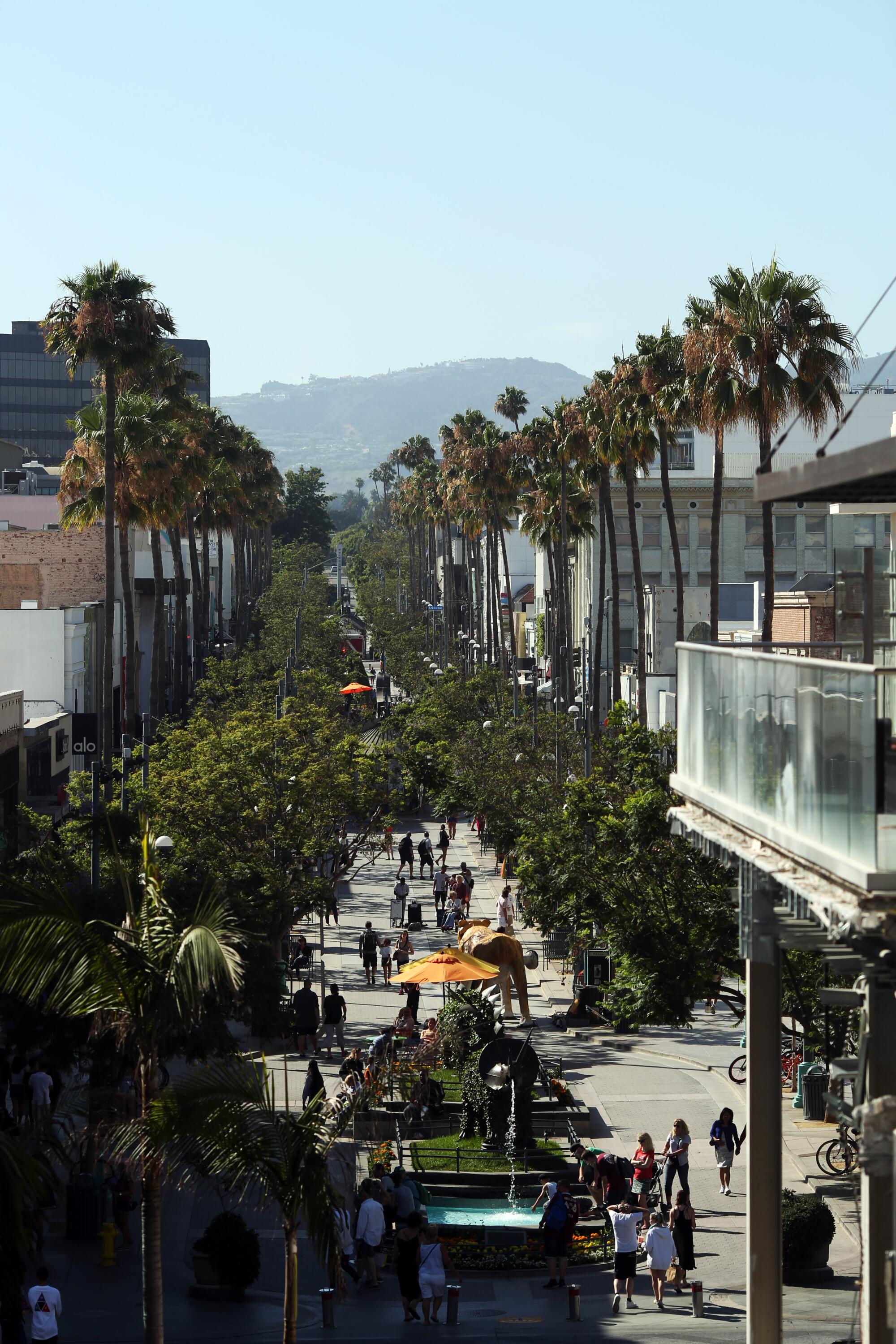
Even the California Department of Forestry and Fire Protection forbids recipients of its urban and community forestry grants to plant them.
“The reason that we don’t allow palms is because the benefit-to-cost ratio is not amenable,” said Walter Passmore, Cal Fire’s state urban forester. “They require a lot of maintenance and do not provide a lot of benefits in comparison to trees.” (Palms are closely related to grasses).
Trees provide myriad benefits. They capture stormwater runoff, replenish groundwater and slow the deterioration of streets. They clean the air and improve mental health. And increasingly during deadlier and record-breaking heat waves — shade trees cool air and surfaces of the built environment, and can reduce energy consumption for air conditioning by up to 30%. One study by the UCLA Luskin Center found that shade can reduce heat stress in the human body from 25% to 30% throughout the day.
A judge has issued a preliminary injunction requiring the city of Beverly Hills to spare 36 ficus trees slated for removal.
Those benefits are critical now but could save more lives by mid- and late century, when daily maximum average temperatures in California are projected to rise 4.4 to 5.8 degrees and 5.6 to 8.8 degrees, respectively.
Researchers have found that neighborhoods with few trees and many roads, buildings and other heat-absorbing infrastructure can be 10 degrees hotter than surrounding areas. Shaded surfaces may even be 20 to 45 degrees cooler than the highest temperatures of unshaded surfaces, according to one estimate by the Environmental Protection Agency.
Every year, heat kills more Americans than flooding, tornadoes and hurricanes combined. Heatstroke can occur without warning. It’s a danger borne unequally by low-income and non-white communities, who have less canopy cover than more affluent areas.
As climate change makes extreme heat episodes more likely, and the electric grid struggles to meet demand for air conditioning, experts say cities need to improve their designs to keep people cool, which will require investments in urban trees, forests and infrastructure.
“What happens when the power goes out?” said Travis Longcore, adjunct professor in the UCLA Institute of the Environment and Sustainability. “You cannot be resilient in an environment where your entire comfort depends on the A/C working.”
But when it comes to shading and cooling, not all trees are created equal.
Paved surfaces, tree cover, and home construction quality can make the difference between heat waves being an inconvenience or a threat to your life.
The Mexican fan palm, the most ubiquitous palm in L.A. County and the second-most planted species, can grow up to 100 feet tall and form a canopy width of 10 to 18 feet. They can shade sidewalks and streets, but only when the sun is directly above them. A coast live oak, on the other hand, can grow to a height of 70 feet, and its large canopy typically spreads nearly twice its height.
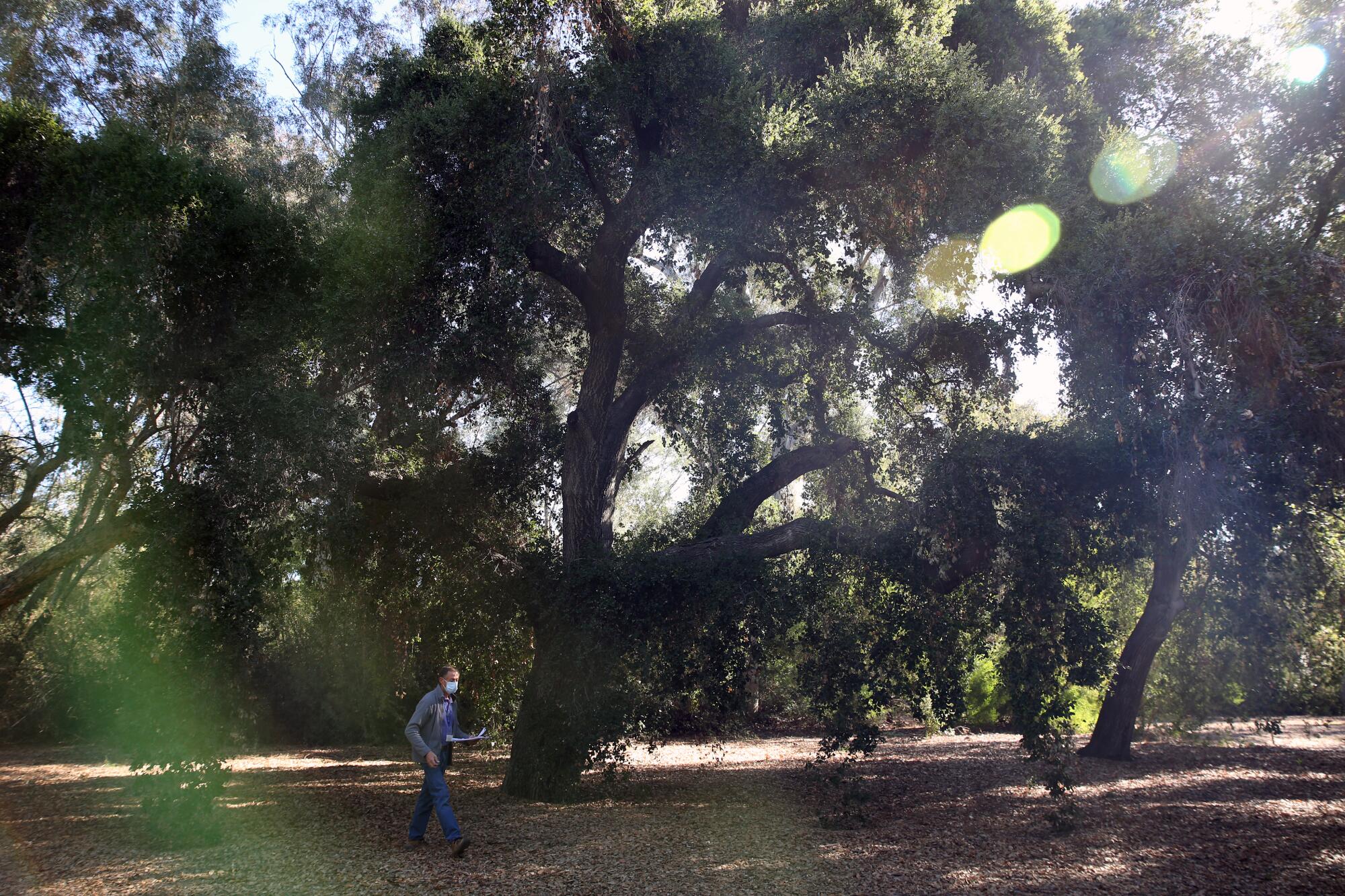
“All those environmental services and benefits that we need from our trees, palms do on a very marginal scale in comparison and we only have so much space,” said Ryan Allen, an arborist and tree-risk assessor with Dudek, an environmental, planning and engineering firm. “So if you have the option of a palm or a shade tree, we’re missing opportunities if we’re planting palms.”

Subscribers get exclusive access to this story
We’re offering L.A. Times subscribers special access to our best journalism. Thank you for your support.
Explore more Subscriber Exclusive content.
Beverly Hills’ Urban Forest Management Plan, prepared by Dudek, said that palms account for 20% of the city’s tree inventory but provide only 0.8% of its canopy cover and 4% of environmental services. Compared with shade trees, which provided more than 2.3 million square feet of canopy cover across the city, palms offered only 321,857.
The plan recommends that existing palms that don’t have historic significance or generate economic value through tourism “should be assessed and selected for strategic removal and replacement with a service-providing shade tree. ... As the City prepares to take progressive steps towards climate resiliency, it will need to decide how to use the limited available space to plant shade trees and expand tree canopy cover.”
In an email, the city said it plans to replace the ficus trees with alternating palms because some property owners along Robertson Boulevard wanted an identity uniform with other streets.
Some 87 ficus trees on Robertson Boulevard will be cut down for a sidewalk project. For some, the removals are bittersweet. For others, they feel like a death.
“Beverly Hills has a canopy cover of 26%, which is above the baseline canopy cover of 20% expected for cities in the Southern California region,” the city said in an email. “The City has a goal to enlarge its tree canopy to 33% in the coming years and continues to find responsible ways to sustain its current canopy while also offering long-term benefits for both the environment and the community.”
Long Beach, on the other hand, has a canopy cover of roughly 15% — lower than the L.A. County average, according to a canopy map viewer. The Long Beach Tree Advisory Committee several years ago recommended that the city minimize its “widespread use of Fan Palms” and consider trees that offered more benefits.
“There are far, far too many palms,” opined Ben Fisher, an arborist and Long Beach resident. “And there’s far too narrow of a palette being used in the city. Another concern in terms of climate resilience is the diversity of our trees.”
“The City of Long Beach understands the importance of plants and trees to our neighborhoods and communities, especially in areas that lack urban tree canopy,” the city’s Public Works Department said in a statement. “The project team typically includes a landscape architect and arborist who carefully consider the benefits to our communities and neighborhood prior to completing the designed plans. Selected plants and trees are drought tolerant and/or zone-appropriate. We also consider commonly used landscaping/hardscaping throughout Southern California as well.”
There are instances, however, where palms fulfill a need.
Big cities are often siloed across departments, which can have competing goals, interests and not prioritize climate adaptation plans. They must also consider community input and how large trees might obstruct nearby utilities and traffic visibility. Sometimes, there’s just not enough space above or below ground.
That’s where palms could come in, because they don’t compete for light or space, said Pete Smith, urban forestry program manager at the Arbor Day Foundation. “The long, tall, skinny palm way above all the other trees ... that’s a feature of that species, not a detriment, because it really doesn’t compete much at all with that nearby oak tree or sycamore that can get a lot of leaf surface area and produce a lot more benefits.”
Space is also a factor when deciding on trees. “In many of our high-need communities, we only have a 4-by-6-foot-wide space, which makes it so we have to plant small factor species that will provide some benefit but not nearly the level of shade coverage and other services that we know that they need for those residents,” said Rachel Malarich, the city’s forest officer. Although they’re not planting palms, she said her office is working with other departments on how to create space for larger shade trees, particularly natives.
Los Angeles, Sacramento, San Diego and other California communities will get $103 million in federal funding for tree planting and other green space efforts.
Palms may not be climate change fighters, but they are culturally significant, and there’s value in preserving and planting them when appropriate, said Matt Ritter, a professor and director of the Cal Poly San Luis Obispo Plant Conservatory. But the best trees are ones that will not only survive urban challenges and climate change, but provide ecological benefits and protect people, he said.
“If we don’t have good urban forests in urban areas in California, people are going to die [during heat waves], and particularly poor, brown people are going to die,” he said. “Because they have the least amount of resources and the least amount of urban forest.”
Experts said that adapting to climate change will require cities to preserve trees when possible, plant a diversity of trees and opt for large ones when it’s appropriate, and rethink how they fit into urban plans.
“We design streets and sidewalks and building areas to accommodate people, not to accommodate plants,” Hodel said. “And I think that’s a big mistake. Especially as the climate becomes more severe, we need to be able to accommodate plants, so that we can have the amenities and benefits that they provide during this period of severe climate.”

